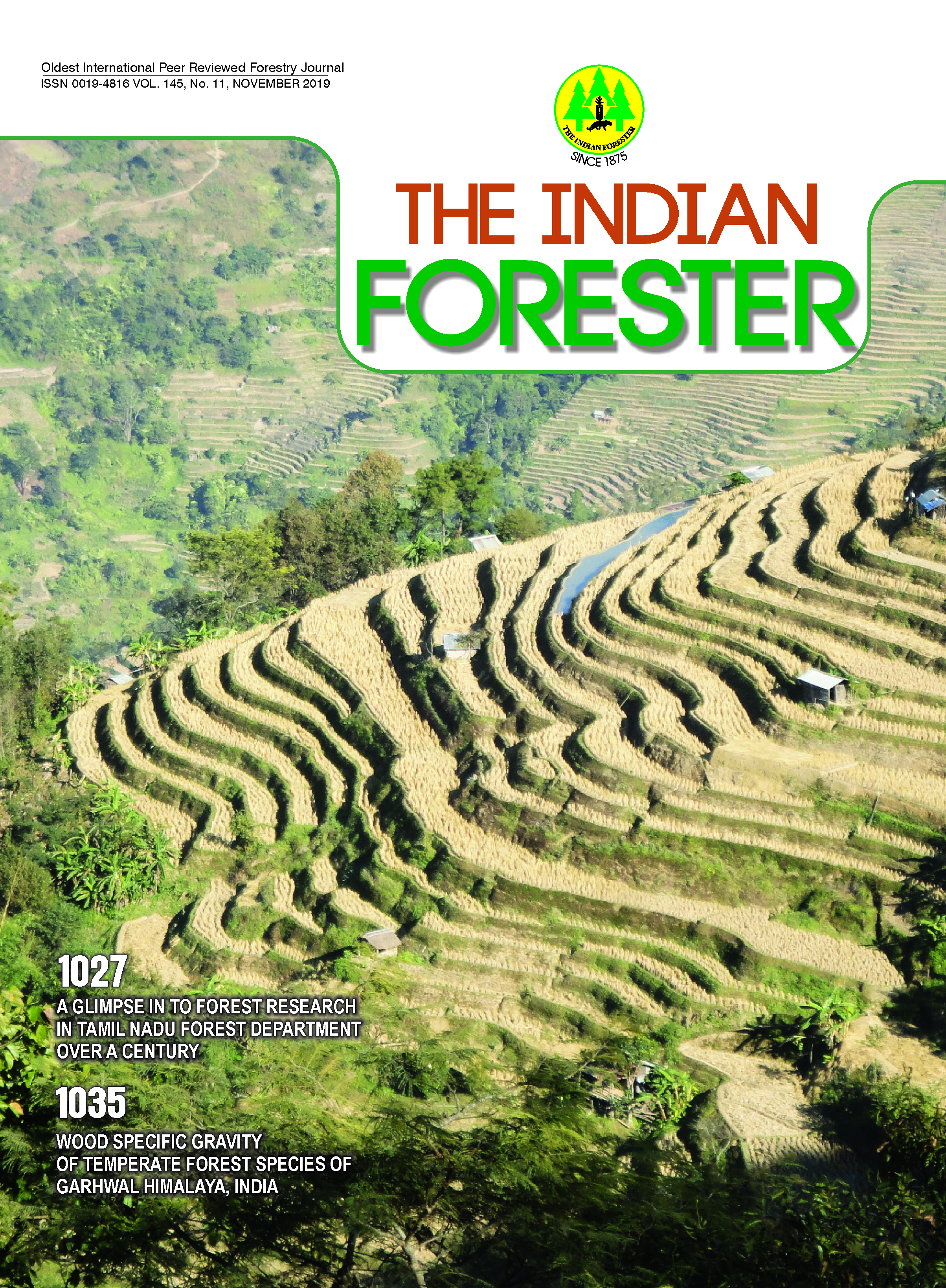Wood Specific Gravity of Temperate Forest Species of Garhwal Himalaya, India
DOI:
https://doi.org/10.36808/if/2019/v145i11/149914Keywords:
Stem Core, Temperate Species, Uttarakhand Himalaya, Wood Specific Gravity.Abstract
One of the parameters for terrestrial biomass estimation is specific gravity of the woody species. Present study reports wood specific gravity of 26 species. Maximum moisture content method was used to calculate specific gravity. Specific gravity of eight species (8) was found between 0.71 - 0.80, seven species between (0.61 - 0.70) and specific gravity of 0.31 - 0.40 was recorded for only one species. Out of 26 species, Cedrus deodara has the highest specific gravity and the lowest value was recorded for Rubus ellipticus.References
Baker T.R., Phillips L.O., Malhi Y., Almeida S., Arroyo L., Difiore A., Erwin T., Killeen J.T., Laurance G.S., Laurance F.W., Lewis L.S., Lloyd J., Monteagudo A., Neill A.D., Patino S., Pilan A.C.M., Silva M.N.J. and MartÃnez V.R. (2004). Variation in wood density determines spatial patterns in Amazonian forest biomass. Global Change Biology, 10: 545-562.
Bhatt B.P. and Todaria N.P. (1990). Fuelwood characteristics of some mountain trees and shrub, Biomass , 21: 233-238.
Bhatt B.P. and Todaria N.P. (1992). Firewood characteristics of some mountain trees and shrub, Commonwealth Forestry Review , 71 (314) : 183-185
Bhatt B.P. and Todaria N.P. (1992). Fuelwood characteristics of some Indian mountain species. Forest Ecology and Management, 47: 363-366
Chave J., Coomes D., Jansen S., Lewis L.S., Swenson G.N. and Zanne E.A. (2009). Towards a worldwide wood economics spectrum. Ecology Letters, 12 : 351–366.
Chowdhury K. A. and Ghosh S.S. (1958). Indian Woods their Identification, Properties and Uses. Manager Publications, Delhi, India 1, 304.
Culmse H., Leuschner C., Moser G. and Pitopang R. (2010). Forest aboveground biomass along an elevational transect in Sulawesi, Indonesia, and the role of Fagaceae in tropical montane rain forests. Journal of Biogeography, 37: 960–974.
Harris J.M. and Meylan B.A. (1965). The influence of microfibril angle on longitudinal and tangential shrinkage of Pinus radiata. Holzforschung, 19: 144-153.
Jacobsen A.L., Pratt B.R., Davis D.S. and Ewers W.F. (2008). Comparative community physiology: non-convergence in water relations among three semi-arid shrub communities. New Phytologist , 180: 100–113.
Muller-Landau H.C. (2004). Interspecific and inter-site variation in wood specific gravity of tropical trees. Biotropica, 36: 20–32.
Negi A.K. and Todaria N.P. (1993). Fuelwood evaluation of some Himalayan trees and shrub, Energy, 18 (8): 799-801.
Panshin A.J. and De zeeuw C. (1980). Textbook of Wood Technology., 4th ed. McGraw Hill Book Company, New York.
Rajput S.S., Shukla K.N. and Gupta V.K. (1985). Specific gravity of Indian timbers. Journal of Timber Development Association of India, 31 (3): 12-41.
Sheikh M.A, Kumar M. and Bhat J.B. (2011). Wood specific gravity of some tree species in the Garhwal Himalayas, India. Forestry Studies in China, 13 (3): 225-230.
Smith D.M. (1954). Maximum moisture content method for determining specific gravity of small wood samples. United States Department of Agriculture Forest Service, Forest Products Laboratory Report No. 2014, Madison and Wisconsin.
Wiemann M.C. and Williamson B.G. (1989). Wood specific gravity gradients in tropical dry and montane rain forest trees. American Journal of Botany, 76: 924-928.
Zanne A.E., Westoby M., Falster S.D., Ackerly D.D., Loarie R.S., Arnold J.S. and Coomes A.D. (2010). Angiosperm wood structure: global patterns in vessel anatomy and their relation to wood density and potential conductivity. American Journal of Botany, 97: 207–215.
Zobel B.J. and Jett J.B. (1985). Genetics of wood production. Springer, Berlin, Heidelberg, New York. 337p.
Downloads
Downloads
Published
How to Cite
Issue
Section
License
Unless otherwise stated, copyright or similar rights in all materials presented on the site, including graphical images, are owned by Indian Forester.





